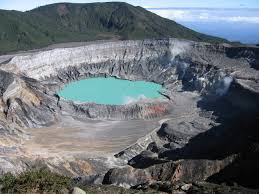GS 3

Poás Volcano, one of Costa Rica’s most visited tourist destinations, recently erupted, drawing significant attention.
About Poás Volcano
Poás is known as one of Costa Rica’s most active volcanoes and is situated within the Poás Volcano National Park. It is a composite stratovolcano with a complex, irregular shape, covering a base area of around 400 square kilometers. Standing at 2,708 meters above sea level, it is a prominent feature of the region.
The volcano has been formed by several eruptive centers, which have led to large collapse craters. Its main crater spans approximately 1.5 kilometers in width and is 300 meters deep, making it one of the largest active craters in the world.
Since 1989, Poás has significantly increased its emission of gases, contributing to acid rain, which has damaged the local vegetation in the park and nearby agricultural lands. In 2024, the volcano’s crater lake began to dry up, resulting in ash-producing eruptions and an increase in gas emissions. There have also been small explosions that have thrown rocks, and the drying process continues.




